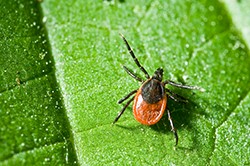If your dog or cat is constantly itchy, they just might have allergies. Dogs and cats suffer from allergies just like humans do, but their symptoms tend to be different. Once you know the “what” and the “why” of pet allergies, it’s easier to help your pet find relief.
Allergy basics
An allergy results when the immune system overreacts or becomes hypersensitive to a harmless and often common substance (called an allergen) that enters or comes in contact with the body. Essentially, the immune system thinks the substance/allergen is dangerous and tries to destroy it. You can think of an allergy like an oversensitive car alarm that sounds at the slightest trigger.
Signs of pet allergies
Most pets with allergies have skin issues. Itching is often the most obvious sign, causing allergic pets to:
- Scratch obsessively
- Rub against furniture
- Shake their head
- Frequently lick, chew, bite, or groom themselves, sometimes to the point of hair loss or hot spots (painful, raw, inflamed areas on the skin that may bleed)
Some pets with allergies also get bacterial or yeast infections from excessive scratching and overgrooming. These are referred to as “secondary infections” and contribute to your pet’s itch and discomfort.
Types of pet allergies
Seasonal allergies and atopy
Seasonal allergy and atopy describe the same type of allergic skin disease. Most dogs with atopy experience itching during certain seasons. Other affected dogs will have problems year-round, which means that the allergen is constantly present or that the dog has developed multiple allergies.
- Seasonal allergies are typically caused by trees, weeds, and other plants that pollinate during a specific time of year, as well as some moulds that tend to bloom indoors and outdoors.
- In Quebec, pets may encounter pollen in the spring from trees including cedar, juniper, boxelder, and maple. Pets may also have allergies to grasses like bluegrass, hay and turf from May to October or even later in the year. Late in the summer and into the fall, ragweed may be responsible for allergy symptoms in pets.
- Common allergens that cause problems year-round include house dust mites, storage mites, and mould spores.
Signs of seasonal allergies or atopy include:
- Chewing or licking the feet, resulting in red, swollen paws or brown staining on the feet.
- Ear inflammation or infections.
- Anal gland issues.
- Irritation and itching (with or without hair loss) can also occur in the groin, underarms, ankles and around a pet’s eyes or muzzle.
- Although less common, seasonal allergies can cause nasal discharge and sneezing in pets, similar to human symptoms.
Flea allergies
When fleas bite, pets can have an allergic reaction to certain proteins in the fleas’ saliva. This is sometimes called flea bite hypersensitivity and can lead to flea allergy dermatitis (FAD). FAD may be more common in warmer months, but can occur year-round because fleas can survive indoors throughout the year.
Pets with flea allergy dermatitis often have:
- An itchy rash or raw, irritated areas on their skin
- Hair loss in specific patterns
- Cats: around the head, neck, lower back, stomach, and thighs
- Dogs: around the tail, back legs, and stomach
Food allergies
Allergies to food are not that common in pets, but they can happen.
- Grains are a less common cause of allergies in pets, whereas animal proteins like chicken, beef, eggs, fish, or dairy are the cause of most pet food allergies.
- Pets with food allergies can have gastrointestinal symptoms, like vomiting and diarrhea, in addition to itchy skin.
Getting your pet relief from allergies
Allergies can be tricky to treat in pets. Some dogs and cats respond quickly to treatment, whereas others may need longer-term management.
For seasonal and other environmental allergies:
- Bathe your pet after they’ve been outside to remove pollen and other allergens. Ask your veterinarian for pet shampoo recommendations.
- Wash your pet’s bedding frequently to minimize their exposure to allergens.
- We can prescribe oral and/or topical medications to give your pet relief from itching.
- Some pets might benefit from allergen-specific immunotherapy (commonly known as allergy shots), which desensitizes pets to specific allergens over time.
- There are also some newer oral and injectable treatment options (also called immune modulators) to help itchy pets. These can provide rapid and long-term relief for pets with allergies.
- Any secondary yeast or bacterial infections need to be treated, so we may run tests to make sure we’re targeting the right culprit and giving your pet the most effective treatment.
For flea allergy:
- Flea allergy can be treated and prevented by keeping pets on flea control products. We may also prescribe other medications, depending on the individual pet.
For food allergy:
- The only reliable test for food allergies in pets is a two- to three-month hypoallergenic diet trial. This is a diagnostic test in which the only food the pet eats is the hypoallergenic food /ingredients prescribed by your veterinarian. Your pet cannot have any other food, treats or flavoured medications. By strictly controlling what your pet eats, the ingredient(s) that trigger an allergic reaction can be identified and/or ruled out.
- Your veterinarian will recommend the best diet for your pet for a diet trial and if needed, for long-term management of a food allergy.
If your pet is showing signs of allergies or you’re concerned about your itchy pet, give us a call, or schedule an appointment with a veterinarian at Vet Mobile Plus today. We’ll rule out other potential causes of your pet’s symptoms and work with you to tailor therapy to your pet.
The veterinary team at Vet Mobile Plus will help your allergic pets get the relief they deserve!

 Several veterinary associations sponsor Pet Dental Health Month every February to raise awareness of the importance of oral health. Good dental hygiene is just as important for pets as it is for humans. However, it is one of the most disregarded areas in pet health despite being the number one diagnosed problem in dogs and cats. It is often referred to as “the silent killer” and has been linked to numerous problems including heart, lung and kidney disease.
Several veterinary associations sponsor Pet Dental Health Month every February to raise awareness of the importance of oral health. Good dental hygiene is just as important for pets as it is for humans. However, it is one of the most disregarded areas in pet health despite being the number one diagnosed problem in dogs and cats. It is often referred to as “the silent killer” and has been linked to numerous problems including heart, lung and kidney disease. Not all pets will be cooperative at first with brushing. You would want to acclimate your pet gradually. You can start by applying a small amount of tooth paste to your finger and quickly/gently rub along the top teeth and gum line. Ideally, you should habituate puppies and kittens when they are young, so that it isn’t a stressful intervention when they are older. The AVMA has put together a great video to show you how to brush your pet’s teeth and address the issue of acclimation.
Not all pets will be cooperative at first with brushing. You would want to acclimate your pet gradually. You can start by applying a small amount of tooth paste to your finger and quickly/gently rub along the top teeth and gum line. Ideally, you should habituate puppies and kittens when they are young, so that it isn’t a stressful intervention when they are older. The AVMA has put together a great video to show you how to brush your pet’s teeth and address the issue of acclimation.

 The seriousness of diarrhea depends on how long the diarrhea has persisted and how many other symptoms accompany the diarrhea. If your dog has severe bloody diarrhea, or is showing more generalized signs of illness such as weakness, fever, vomiting, abdominal pain or loss of appetite, or if dehydration accompanies the diarrhea, the cause may be more serious. For example, diarrhea is one of the first symptoms seen in parvovirus, a viral infection that can cause life-threatening illness in susceptible dogs.
The seriousness of diarrhea depends on how long the diarrhea has persisted and how many other symptoms accompany the diarrhea. If your dog has severe bloody diarrhea, or is showing more generalized signs of illness such as weakness, fever, vomiting, abdominal pain or loss of appetite, or if dehydration accompanies the diarrhea, the cause may be more serious. For example, diarrhea is one of the first symptoms seen in parvovirus, a viral infection that can cause life-threatening illness in susceptible dogs.



 I thought it would be fun to add a twist of my own during this campaign by looking at the health benefits of pet ownership to people. There is an increasing amount of research and anecdotal evidence on the subject. According to the CDC (Centers for Disease Control) and the NIH (National Institute of Health), the health benefits are both from a physical and psychological point of view.
I thought it would be fun to add a twist of my own during this campaign by looking at the health benefits of pet ownership to people. There is an increasing amount of research and anecdotal evidence on the subject. According to the CDC (Centers for Disease Control) and the NIH (National Institute of Health), the health benefits are both from a physical and psychological point of view. Pets can increase your opportunities for exercise and outdoor activities as well as opportunities for socialization and have even been coined as date magnets by some. People are certainly more likely to start a conversation with you when you are accompanied by a furry friend. According to one health magazine, dog owners were more likely to complete the recommended minimum 150 minutes of exercise per week.
Pets can increase your opportunities for exercise and outdoor activities as well as opportunities for socialization and have even been coined as date magnets by some. People are certainly more likely to start a conversation with you when you are accompanied by a furry friend. According to one health magazine, dog owners were more likely to complete the recommended minimum 150 minutes of exercise per week.

 Although there are at least 15 species of ticks in North America, only a few of these species are likely to be encountered by your dog. They include the:
Although there are at least 15 species of ticks in North America, only a few of these species are likely to be encountered by your dog. They include the: All three active stages of the deer or blacklegged tick will feed on a variety of hosts including dogs and people. After the eggs hatch in the spring, the very tiny larvae feed primarily on white-footed mice or other small mammals. The following spring, the larvae molt into pinhead-sized, brown nymphs that will feed on mice, larger warm-blooded animals and people. In the fall, they molt into adults that feed primarily on deer, with the females laying eggs the following spring. Adults are reddish-brown and about 1/8-inch long (or about one-half the size of the more familiar American dog tick).
All three active stages of the deer or blacklegged tick will feed on a variety of hosts including dogs and people. After the eggs hatch in the spring, the very tiny larvae feed primarily on white-footed mice or other small mammals. The following spring, the larvae molt into pinhead-sized, brown nymphs that will feed on mice, larger warm-blooded animals and people. In the fall, they molt into adults that feed primarily on deer, with the females laying eggs the following spring. Adults are reddish-brown and about 1/8-inch long (or about one-half the size of the more familiar American dog tick).
